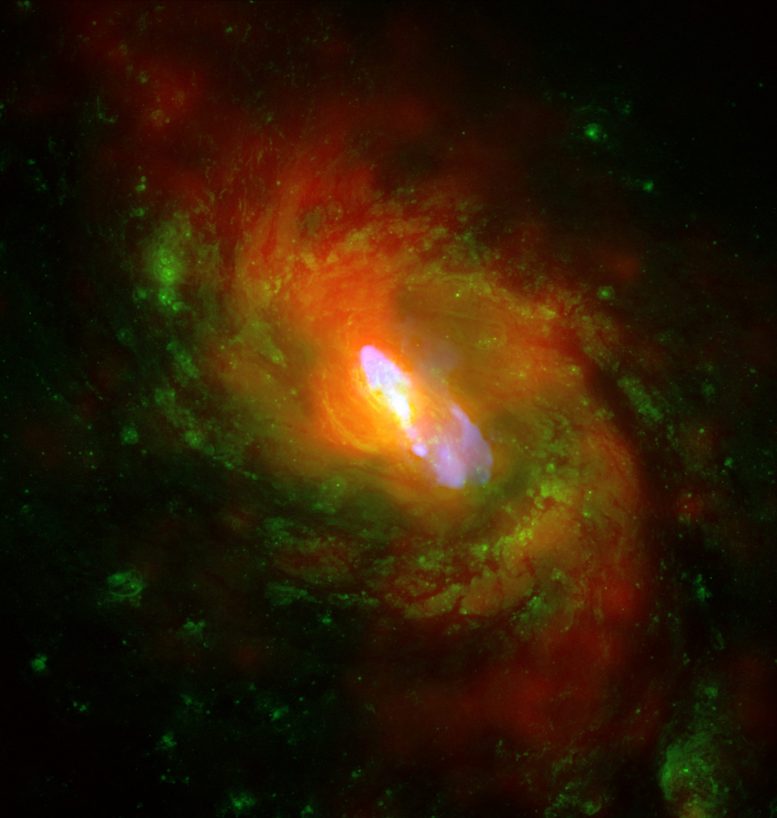
This is a composite image of NGC 1068, one of the nearest and brightest galaxies containing both a rapidly growing supermassive black hole and star formation. A new study shows that, on average, both black hole accretion and star formation grow at similar rates, perhaps related to how material flow into the respective regions. X-ray data from the Chandra X-ray Observatory are shown in red, optical data from the Hubble Space Telescope in green, and radio data from the Very Large Array in blue. Credit: NASA and Chandra
By comparing data from the Chandra X-ray Observatory with infrared observations by the Spitzer and Herschel space telescopes, astronomers discovered an almost linear relationship between the average black hole accretion rate and the star formation rate for galaxies across a wide range of luminosities.
Supermassive black holes (those with millions to billions of solar masses) are thought to reside at the centers of most galaxies. These black holes must have undergone periods of intense accretion activity to grow to their large sizes, during which times they would be observed as active galactic nuclei and especially bright in X-rays. The masses of these black holes have been found to correlate closely with the cumulative mass of the stars that surround the galaxy in its bulge (and which are bound by gravitational forces). In a second discovery, it turns out that the activity of accretion for black holes and of star formation both peaked during a similar cosmic epoch, about three billion years ago, and then declined to the present day. These two results seem to suggest parallel evolutionary paths for the growth of the black holes and stellar mass, but the physical mechanisms that drive this apparent link, if it exists, are poorly understood. To make matters more confusing, some studies of individual objects have concluded that there is little or no correlation, or even an inverse one.
Both black hole accretion and star formation require a supply of gas, and the clues to uncovering any connections between their growth may lie in the gas fueling mechanisms that supply them. CfA astronomers Christine Jones, Bill Forman, and Andy Golding, along with a team of collaborators, reasoned that because star formation occurs over time scales of hundreds of millions of years whereas active black hole accretion can vary rapidly over millions of years, the most appropriate measure to use when comparing these two processes was a long time average.
The scientist studied 121 active galaxies studied by the Chandra X-ray Observatory that were also observed in the infrared by the Spitzer and Herschel space telescopes. The former provided an average measure of accretion activity, while the latter, which detected the dust warmed by young stars, sampled the star formation activity. With this approach the astronomers found an almost linear relationship between the average black hole accretion rate and the star formation rate for galaxies across a wide range of luminosities. The result implies that there are indeed tight links between the two activities in galaxies.
Reference: “A Correlation between Star Formation Rate and Average Black Hole Accretion in Star-forming Galaxies” by Chien-Ting J. Chen, Ryan C. Hickox, Stacey Alberts, Mark Brodwin, Christine Jones, Stephen S. Murray, David M. Alexander, Roberto J. Assef, Michael J. I. Brown, Arjun Dey, William R. Forman, Varoujan Gorjian, Andrew D. Goulding, Emeric Le Floc’h, Buell T. Jannuzi, James R. Mullaney and Alexandra Pope, 18 July 2013, The Astrophysical Journal.
DOI: 10.1088/0004-637X/773/1/3
arXiv:1306.1227









Be the first to comment on "A Link Between Black Hole Accretion Rate and Star Formation Rate"